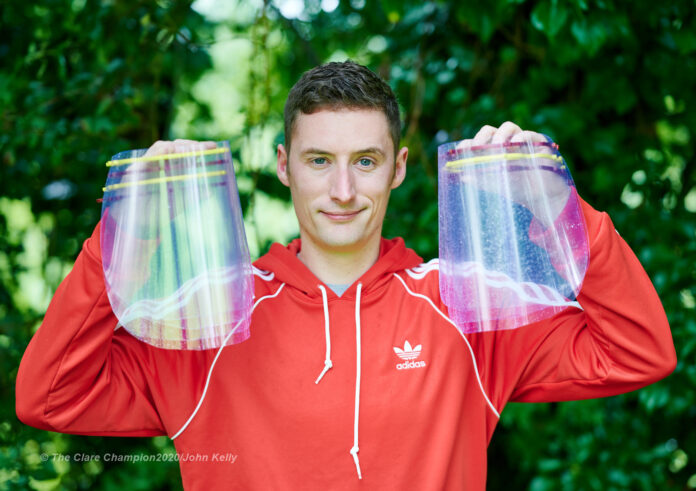A BRIDGETOWN technology and engineering teacher put his skills to good use during the Covid-19 lockdown by making and distributing protective about 2,400 visors for frontline staff in health care facilities and hospitals.
Tom English teaches in St Clements school in Limerick. Using a 3D printer from his home, he supplied vital Personal Protective Equipment (PPE) free of charge when it was in extremely short supply.
The visor includes a strong plastic band with a shield that drops down to protect a person’s face. The main benefit of a visor is to prevent fluid transmission between people.
“I had the machinery in school and before the schools closed down and took home three of my own 3D printers.
“In the first week of April, I test printed five or six different designs to see what would be suitable. There were loads of different designs available on line.
“It was more a case of curiosity more than anything else. By the end of the week, I realised I had about 70 made, which were good quality.
“I started a fundraiser on GoFundMe, which raised about €4,000. This helped me to purchase four more printers and the materials to produce the visors,” he said.
After making the new visors, he recalled that he distributed 70 to nursing homes in Limerick and North Tipperary in the first week of production.
He also got feedback from nursing home staff to make sure they were suitable and they were delighted with the quality.
This coincided with the arrival of a large consignment of Personal Protective Equipment (PPE) from China, some of which couldn’t be used because it didn’t meet the required specification.
This resulted in an increase in demand for his visors.
At the start of the project, he printed and distributed visors in health care facilities throughout the Mid-West.
He contacted the University Hospital Limerick and Ennis Hospital prompting an increase in production with the weekly distribution of about 200 visors to these acute facilities.
“This was a big help to the hospitals as they couldn’t use the stuff they had. Initially, it was nurses and doctors who were contacting me and then I contacted the procurement officer in UHL and when he saw the product he was delighted with it.
“A lot of the nursing homes had deaths early on and they were concerned for their residents. I was often contacted by staff in nursing homes because they couldn’t get PPE from the HSE,” he said.
After a few weeks, Limerick Institute of Technology opened up a new processing hug in their old exam hall staffed by volunteers.
He estimates there were up to 30 people printing visors from their homes in the Mid-West and Galway. Bikers used to collect visors from peoples’ homes and bring them to LIT for processing, which saved Mr English and other visor producers a lot of time.
Volunteers from clubs like Na Piarsaigh GAA Club came in to LIT to do the processing, quality control, sterilisation and packaging on different nights.
He said the LIT hub was very well run by Ciaran O’Loughlin from LIT as all the volunteers were spread two metres apart in different stations to ensure they didn’t spread or contract Covid-19.
He received a lot of help from his mother, Bernie, who monitored the printing and changing visors after production while he was distributing visors.
“One of the questions that needs to be asked is why was there such a need for PPE. There were about 30 people printing visors from home.
“There were two people from Spanish Point, people in Castletroy and different parts of Limerick, Galway and Tipperary 3D printing from home. People started doing this organically from home and then a centralised network evolved from it.
The HSE stated a number of times they had no issue getting PPE or distributing it yet there was still a huge demand for the visors.
“I don’t any answers but it is the thing that bothers me,” he said.
He recalled a group from Cork, Bench Space, devised a model for collecting the visors and processing them, which LIT replicated to a large degree.
Johnson and Johnson, who are based in Castletroy, Limerick are now making an injection molded visor.
An injection molded machine is a lot faster than a 3D printer and the company can produce about 3,000 visors daily.
Dan Danaher
East Clare correspondent, Dan Danaher is a journalism graduate of Rathmines and UL. He has won numerous awards for special investigations on health, justice, environment, and reports on news, agriculture, disability, mental health and community.



